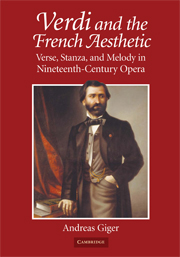Book contents
- Frontmatter
- Contents
- Acknowledgments
- Introduction
- Part I VERSIFICATION AND MELODIC AESTHETICS
- 1 Rhythm and stanza in French and Italian librettos
- 2 French and Italian melodic aesthetics and practice ca. 1830–1870
- Episode: Design, middleground rhythm, and phrase
- Part II FRENCH MELODY IN VERDI'S OPERAS
- Appendix: Principal theoretical texts cited (arranged in chronological order by date of publication)
- Notes
- Bibliography
- Index
2 - French and Italian melodic aesthetics and practice ca. 1830–1870
Published online by Cambridge University Press: 22 September 2009
- Frontmatter
- Contents
- Acknowledgments
- Introduction
- Part I VERSIFICATION AND MELODIC AESTHETICS
- 1 Rhythm and stanza in French and Italian librettos
- 2 French and Italian melodic aesthetics and practice ca. 1830–1870
- Episode: Design, middleground rhythm, and phrase
- Part II FRENCH MELODY IN VERDI'S OPERAS
- Appendix: Principal theoretical texts cited (arranged in chronological order by date of publication)
- Notes
- Bibliography
- Index
Summary
Music intended to fit a libretto requires of a critic all the attention and study regarding suitable melody, phrasing, rhythm, cut, harmony, and accompaniment.
– Abramo BaseviSome of the conventions a composer had to follow when writing for the Paris Opéra have long been well known: a four- or five-act design, grand emotions (i.e., a focus on issues that concern a large segment of society rather than isolated individuals), ballets, extended choral sections, musical forms that complied with French expectations (such as ternary aria forms), and certain dramatic requirements. But when it comes to defining French melody in the broadest sense, including consideration of rhythmic and harmonic characteristics, relationship to prosody and accompaniment, and principles of melodic development, opinions have been vague and often contradictory. One nineteenth-century critic for the Gazzetta musicale di Milano, for example, questioned whether the melodic style even at the Opéra could truly pass as French. In reaction to a review in a Berlin paper that detected French influences in Verdi's Rigoletto, the critic responded:
Of what French opera does the Berlin paper speak here? We cannot recognize the true physiognomy of French melody except in comic operas. In serious opera, of which the major temple is the grand Opéra, as someone else observed, French music is cosmopolitan; and in fact, quite rarely are we given the chance to perceive in the grand works performed in that theater the vices inherent in the melody and the music of the French in general.
- Type
- Chapter
- Information
- Verdi and the French AestheticVerse, Stanza, and Melody in Nineteenth-Century Opera, pp. 43 - 77Publisher: Cambridge University PressPrint publication year: 2008



